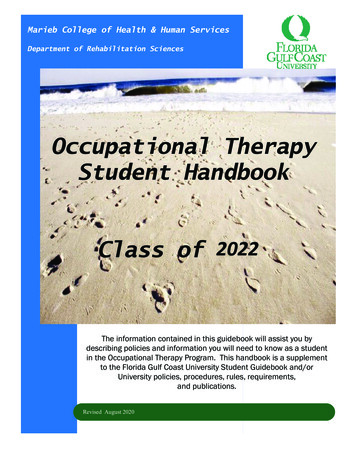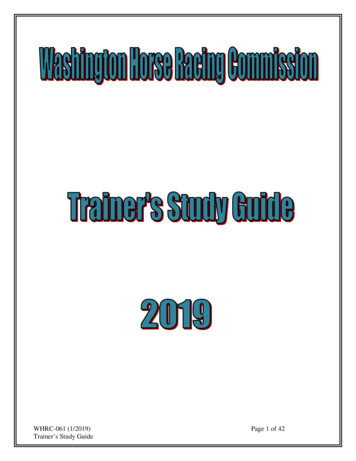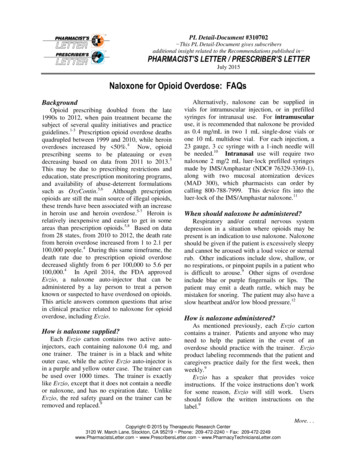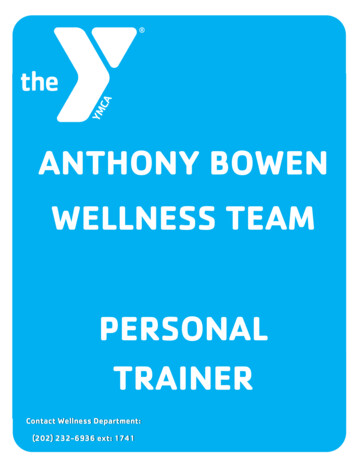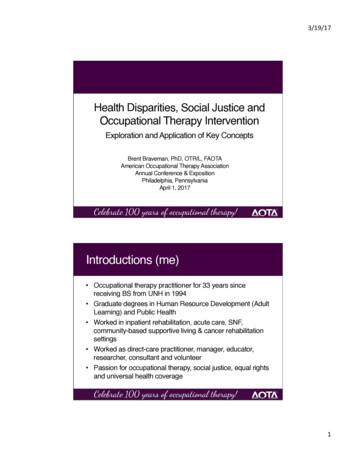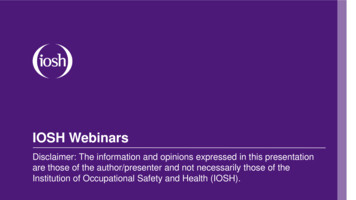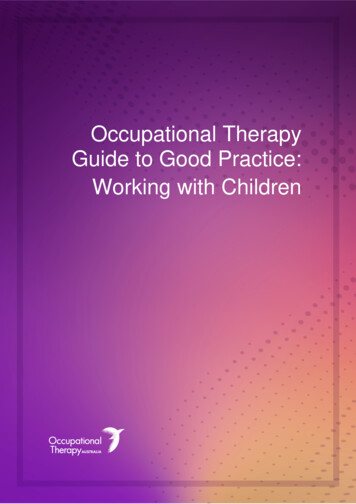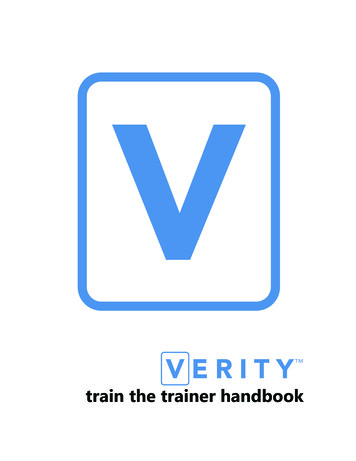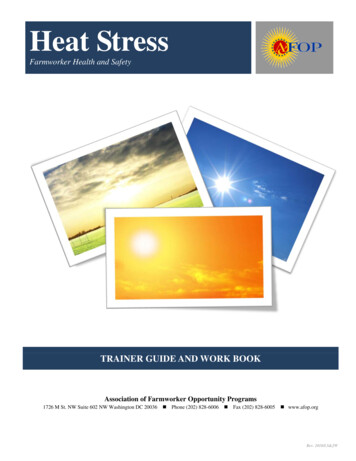
Transcription
Heat StressFarmworker Health and SafetyTRAINER GUIDE AND WORK BOOKAssociation of Farmworker Opportunity Programs1726 M St. NW Suite 602 NW Washington DC 20036 Phone (202) 828-6006 Fax (202) 828-6005 www.afop.orgRev. 2010/LS&JW
Health & Safety Director’s MessageWelcome to AFOP’s Project SOL Heat Stress Prevention Program! Through generous funding from the Susan B. HarwoodTraining Grant Program offered by the U.S. Department of Labor’s Occupational Safety and Health Administration(OSHA), we are able to bring much-needed training to agricultural workers and their employers that will most likelyprevent illness from heat exhaustion or heat stroke, and possibly even save lives.Farmworkers feed the world while working in one of the most dangerous occupations and face unique challenges on adaily basis – poverty, lack of access to education, health care and other services, exposure to dangerous pesticides thatcan cause serious illness, and constant uncertainty about their futures are part of their struggle. Illness brought on byextreme heat is yet another variable that threatens their efforts to support themselves and their families. Besides beinga serious health risk, heat-related illness means time away from work, lost wages, medical bills, and the resulting stresson their families.The good news in this is that heat-related illness and death are preventable and prevention does not cost a great deal ofmoney. AFOP’s Project SOL seeks to bring information and training to agricultural workers and their employers on thedangers of heat-related illness and how to prevent tragic incidents by providing life-saving training and improving thequality of life for farmworkers and their families. We hope you will use the tools provided here and the resourcesavailable from our office to provide the best possible training that farmworkers deserve.Levy SchroederDirector, AFOP Health and Safety Programs*“This material was produced under grant SH-19485-SH9 from the Occupational Safety and Health Administration, U.S.Department of Labor. It does not necessarily reflect the views or policies of the U.S. Department of Labor, nor doesmention of trade names, commercial products, or organizations imply endorsement by the U.S. Government."* 2010 Association of Farmworker Opportunity Programs/Jessica Werder2
Table of ContentsSection I - Heat StressIntroduction 4Heat StressInitial thoughts and expectations 5Training objectives 6Farmworkers – Who are they? . 7Why Heat Stress . 8Heat Stress Definitions 9Heat Stress 101 . 10Symptoms . 11Scenarios 12First-Aid Response . 16Risk Factors . 17Prevention 20OSHA . 21Section II – Training FarmworkersTraining Farmworkers .Tips for a Successful Training Session Know your population .Learning Styles .Your Flipchart . .Self Analysis and Goals .Paperwork .Outreach Training Roster .Pre/Post-Test English Pre/Post-Test Spanish Training Event Summary .References 222325262931323336374043453
IntroductionThis workbook was designed with two purposes inmind:1) to serve as a written companion to the Associationof Farmworker Opportunity Program’s (AFOP’s) trainthe-trainer course on heat stress prevention and;2) to be a reference tool for you and yourorganization when providing heat stress preventiontrainings in the future.With this idea in mind, the book before you has beendesigned as an interactive tool. It consists ofalternating sections of background information andactivities designed to help you engage with thematerial in a meaningful way. It is our hope that thisdesign will provide a tailored approach to note-taking and information gathering, ultimately providing a usefulbody of information for you, the trainer. We look forward to working with you during this training. We willstrive to ensure that you leave feeling equipped with the necessary knowledge and skills to carry out heatstress prevention trainings in the field.AFOP -AFOP is a membership-based organization located inWashington, DC. Since 1971, AFOP has been working with itsmembers to improve the quality of life for migrant and seasonalfarmworkers in the United States. It is the Association’s beliefthat training and education are key components to achievingchange for the workers who plant, tend and harvest the cropsthat Americans consume at their tables. AFOP member agenciesreceive grants from the United States Department of Labor, andother governmental and non-governmental institutions, toadminister programs aimed at upgrading farmworkers’ skills andproviding essential education, including English Proficiency forthose whose native tongue is another language.AFOP’s Health and Safety Program seeks to mitigate the health hazards facing migrant and seasonalfarmworkers and their families. True to the organization’s mission of providing training and education, theHealth and Safety Alliance has a strong history of developing and implementing train-the-trainer coursesfocused on the promotion of health and safety for members of the farmworker community. In designing thesecourses, AFOP has partnered with government institutions such as the Environmental Protection Agency (EPA)and the Occupational Safety and Health Administration (OSHA).4
Heat StressInitial Thoughts:As you go through introductions and begin to familiarize yourself with your training group and topic, take time to noteany thoughts or questions that come to your head in the space provided below:Expectations:You will likely bring a number of expectations with you to this training– expectations about what you willlearn, about what will be expected of you and about what you will be doing with your new skills. Take amoment to write down your expectations in the space provided below:5
Training Objectives:During this training, we hope that you will learn the basics of heat stress prevention. In addition, we want youto leave feeling confident and ready to carry out trainings with the farmworkers in your communities. To helpguide us in achieving these goals, we have created a number of general objectives for the training, along withmore specific objectives that will allow us to determine if we have met our overall goals. The objectives forthis training are listed below, allowing you to check them off once you have determined that you, as anindividual, have met the goal.Objective A:Trainers understand their role as trainer and know how to do outreach in the community. Each trainer has completed an outreach plan by the end of the two-day training session.Objective B:Trainers understand what heat stress is and how to prevent and respond to it in the field. Trainers can correctly identify 5 symptoms of heat-related illnesses. Trainers can correctly identify at least 5 steps to be taken in caring for a victim of heat-related illnesses. Trainers can correctly identify 3 personal and 3 environmental risk factors for heat-related illnesses. Trainers can identify 3 strategies for preventing heat-related illnesses in the field.Objective C:Trainers are able to conduct heat stress trainings. Trainers have practiced the heat stress training with the flipchart at least twice by the end of the twoday session. Trainers state they feel prepared to give a training to farmworkers on heat-related illnesses.6
Farmworkers – Who are they?As a trainer, you will be working with migrant and seasonalfarmworkers, training them on the prevention of heat stress and heatrelated illnesses (HRI). One of the most important things to consider,once you begin to design your trainings, is the population with whichyou will be working – who they are, where they are from and whatmotivates them.It has been estimated that over 2.5 million migrant and seasonalfarmworkers work in the United States. Most of the demographicinformation that is known about this population comes from theNational Agricultural Workers Survey (NAWS), an ongoing assessmentconducted by the US Department of Labor. The most recent phase ofthe survey, conducted between 2000 and 2002, compiles informationfrom interviews with 6,472 farmworkers. The information gleaned fromthese interviews is used for a wide variety of purposes. For ourpurposes today, it will give us a glimpse into the lives and characteristicsof the people who put the food on our tables, the people with whomyou will be working.The space below has been provided for you to take notes, as you see fit,on the characteristics of the farmworker population and their relevanceto your future work on heat stress prevention.**Remember that a good training starts with knowing your population – who they are, where they come fromand what is important to them.**7
Why Heat Stress?The following case study was reported in the September 2008edition of the Journal of the American Medical Association:“In mid-July 2005, a male Hispanic worker with an H-2A workvisa (i.e., a temporary, nonimmigrant foreign worker hiredunder contract to perform farm work) aged 56 years was handharvesting ripe tobacco leaves on a North Carolina farm. He hadarrived from Mexico 4 days earlier and was on his third day onthe job. The man began work at approximately 6:00 a.m. andtook a short mid-morning break and a 90-minute lunch break.At approximately 2:45 p.m., the employer’s son observed theman working slowly and reportedly instructed him to rest, butthe man continued working. Shortly thereafter, the man’s coworkers noticed that he appeared confused.Although the man was combative, his coworkers carried him to the shade and tried unsuccessfully to get himto drink water. At approximately 3:50 p.m., coworkers notified the employer of the man’s condition. At 4:25p.m., the man was taken by ambulance to an emergency department, where his core body temperature wasrecorded at 108 F (42 C) and, despite treatment, he died. The cause of death was heat stroke. On the day ofthe incident, the local high temperature was approximately 93 F (34 C) with 44% relative humidity and clearskies. The heat index was in the range of 86 –101 F (30 –38 C) at mid-morning and 97 –112 F (36 –44 C) atmid-afternoon.“Similar conditions had occurred during the preceding 2 days. The man had been given safety and healthtraining on pesticides but nothing that addressed the hazards and prevention of heat related stress. Hereportedly only spoke Spanish. Fluids, such as water and soda, were always available to the workers in thefield; however, whether the man drank any of these fluids is unknown.”Heat-Related Deaths among Crop Workers – United States, 1992 – 2006.” (Reprinted) JAMA, September 3,2008—Vol 300, No. 9.The following space has been provided to record your thoughts and/or observations about the previous casestudy and heat stress in general.8
Getting on the same page .DefinitionsHeat Stress:Heat-related illnesses:Heat Stress Notes:9
Heat Stress 101 –Human beings, as a rule, must maintain a constant internal body temperature of roughly 98.6ºF or 37ºC. Thereasons for this are straightforward, having to do with the ideal temperature at which many of our internalchemical reactions and processes function to their fullest potential. While 98.6ºF is ideal, the body’s internaltemperatures are influenced by a host of internal and external factors and must have a system in place toregulate body temperature. At any given moment, the body is engaged in a balancing act of heat generationand heat release.The body acquires heat from a number of different sources including heat that it generates, and heat that itreceives from the surrounding environment. Generated body heat comes primarily from the by-products ofchemical reactions and from the heat generated by the work of the body’s muscles, including those musclesthat cause shivering when a person is cold. Environmental heat comes from the surrounding air, from directlight and from equipment that gives off large amounts of heat. While the human body needs a significantamount of heat to maintain its temperature of 98.6ºF, on occasion, the body acquires too much heat. In theseinstances, the body must release heat, preventing internal temperatures from rising too high.To release heat into the environment, the body must first transfer heat away from the internal core of thebody, toward the body’s surfaces near the skin. This is done by dilating, or widening, the blood vessels on theoutermost parts of the body, near the skin. The heart then works to pump blood to these regions. The bloodcarries heat, which can then be released. There are four primary ways in which the human body releases heat:evaporation, conduction, convection, and radiation.The first of these mechanisms, evaporation, happens when a person sweats. Sweat, a liquid, is releasedthrough glands onto the skin of a person’s body. There, the liquid sweat must use energy to convert itself intoa gas and evaporate. This energy is in the form of heat that the body is trying to release. So, the evaporatingsweat literally takes heat with it as it goes.The second mechanism, conduction, refers to what happens when the body comes into contact withsomething that is cooler than itself. In this instance, heat is actually transferred from the skin of the person tothe cooler object, releasing heat and making the person feel cooler.Convection and radiation are very similar processes. In convection, air passing over the surface of the skin“lifts” heat off of the surface. This is why a person may feel cooler on a windy day. Radiation also releases heatdirectly into the air, but does so even in the absence of wind. Heat simply transfers itself from the body intothe surrounding environment. All of these processes are subconscious, controlled by the human brain.However, sometimes the body becomes so hot that its heat-regulating mechanisms simply can’t eliminateenough heat. When this happens, the internal body temperature begins to rise above 98.6ºF, affecting ourphysiological processes and resulting in strain on the body that we refer to as heat stress. This heat stress onthe body results in symptoms that we categorize into different heat related illnesses (HRIs), based on theirseverity.10
IllnessThe following diagram presents various HRIs and the symptoms that correspond with each.Heat rashPrickly heatHeat crampsSigns and symptoms:Red spots on the skin that resemble blisters; prickly or itchy sensation.What’s happening:Sweat glands become clogged and inflamed when sweat cannot evaporate;happens in humid conditions and/or when clothing traps sweat against theskin.Signs and symptoms: Spasms of the legs, arms or abdomen; often accompanied by heavy sweating andthirst; happens after physical labor.What’s happening:Early heat illnessHeat syncopeHeat exhaustionHeat StrokeA loss of body salt, through sweat, causes water to rush into the muscles, resultingin cramping or spasms.Signs and symptoms: Fatigue; dizziness; irritability; inability to concentrate; impaired judgment.What’s happening:Blood flow to the brain is reduced as the body redirects blood to release heat fromthe skin.Signs and symptoms:Sudden dizziness; pale complexion; moist skin; normal body temperature.What’s happening:Blood flow to the brain is reduced as the body redirects blood to release heat fromthe skin.Signs and symptomsExcessive sweat; dry mouth; extreme thirst; headaches or feeling dizzy;lightheadedness; mood changes or irritability; rapid breathing; chills; fainting orweakness; heat cramps; nausea; decreased or dark-colored urine; pale; moist skin;fatigue.What’s happening:Less blood flow to the brain, resulting from blood flow to the body’s surfaces; thisresults in less oxygen reaching the brain and therefore lightheadedness,headaches, and mood changes; the body’s temperature regulator is stillfunctioning, trying to cool the body.Signs and symptoms: Often occurs suddenly; extremely high body temperatures; lack of sweating;confusion or aggressive behavior; seizures or convulsions; coma in severe cases;unresponsiveness to clapping; dizziness; fast pulse; dry, hot, red skin.What’s happening:Over 150ºF, the body stops sweating and the temperature-regulating system stopsfunctioning due to too much heat; blood flow to the brain is significantly reduced;rising internal temperatures risk damage to organs including the heart, brain,central nervous system, liver and kidney; brain damage or death can result.11
What would you do?The following scenarios depict situations in which one or more individuals are suffering from heat stress and possibly anHRI. Read over the scenarios and decide how you would respond. You have been provided with a number of suggestedsteps for each situation. It is up to you to decide if the steps are appropriate, what order you should perform them in,and if there is any additional care that you should provide for the person affected. Record your response to the situationin the space provided.Even though Fernando was out drinking last night, he still manages to wake up at 5 a.m. to get out to the fields at anearly hour. He packs two bottles of water and is sure to wear a long-sleeved shirt to prevent pesticide exposure. Hearrives at the fields at 7 a.m. and starts to pick onions. The temperature quickly rises to a stifling 100ºF by 11 a.m. Toharvest as much as possible, Fernando doesn’t take any breaks. While Fernando had prepared and brought water, he isthirstier than he realized he would be and finishes his water by 10 a.m. Around 11:30, Fernando begins to feel tired anddizzy. Thinking nothing of it, he keeps working. Soon after, Fernando faints in the fields, where you, his coworkers findhim. What should you do and in what order? Take off Fernando’s boots and socks.Get medical attention.Check to see if Fernando is conscious. If he is, give him water.Loosen his clothing, especially around his neck, chest, and waist.Move Fernando to a shady spot.Splash cool water on Fernando’s body.Tell the crew leader. (One person can do this while another is helping Fernando).12
What would you do?Reyna has been harvesting chiles all morning and the temperature has soared well into the 90ºF’s. Despite the heat,Reyna continues to harvest as quickly as possible, knowing that once her baby is born, she won’t be able to work for afew months. Though she is thirsty, Reyna’s husband has her water and he is a few rows away. Since it is late morninganyway, she decides to wait until lunch break to rehydrate. At lunch, Reyna has a hard time finding a spot in the shadeto rest, so she sits at the end of her row, feeling weak from the hard morning’s work. Reyna’s husband, Mario,approaches and sits to eat lunch with her. Suddenly, Reyna feels dizzy and confused. She lashes out at him, yelling at himfor having her water all morning. Mario is confused because Reyna is not usually an aggressive person. Suddenly, shebegins convulsing and throws up. Mario calls to you, the nearby workers, for help. What should you do and in whatorder? Pour cool water over her body.Wait for the crew leader to arrive, so that he can bring her to the clinic.Clean her mouth of the vomit.Fan her body.Drape a wet shirt over her chest.Move Reyna to a shaded area.Loosen her clothing.Make sure health professionals know that Reyna is pregnant.Remove her shoes and socks.13
What would you do?Maria and Mateo are hanging tobacco leaves in a tobacco shed at the edge of the fields. They are short staffed today sothey have been hurrying between the wagon and the shed, hauling heavier armloads than normal. It is a blistering hotday of 90ºF. Inside the tobacco shed, temperatures have reached 110ºF, and the air feels hot and heavy. Mariasuddenly feels weak and sits down to take a break. She is in the hottest part of the shed, but she can not work up theenergy to move to someplace cooler. Mateo, noticing that she has taken a break, picks up the pace to keep up with theworkload. Soon, he too has a headache and suddenly passes out. As the tobacco starts to pile up outside, your crewdecides to check in on Mateo and Maria to see what’s happening. You find Mateo passed out and Maria looking verysick. The shed is the only shade available in a fifteen minute radius. What should you do and in what order? Check to see if Mateo is breathing. (He is).Move them to fresh air outside the shed, even though it’s under direct sunlight.Keep them in the shed, where there is shade from the sun.Transport them to a medical facility.Send someone to look for the crew leader.Loosen their clothing.Cover Mateo with a wet shirt.Give Maria an energy drink to revive her.Elevate Mateo’s legs.Give Maria water.Fan both of them.14
What would you do?Victor has been working in the fields for the last 45 years. At 65, he considers himself well-adjusted to all conditions thatcan happen while working outside. Today, he is picking strawberries. Victor knows that pesticides are used heavily onthis crop; therefore he has decided to wear an especially thick, long-sleeved shirt to prevent pesticide exposure. Today isnot much different from the many other days that he has spent in the fields. It is hot, almost 100ºF, and there is not acloud in the sky. However, for some reason Victor is feeling more tired than usual. He begins sweating profusely andstarts to breathe heavily. He turns to his coworker to ask for some water, and his coworker comments on his slurredspeech. Victor says that he needs to sit down and his coworker calls to you for help. What should you do and in whatorder? Give him as much water as he can drink.Ask Victor if he thinks he should go to the clinic.Tell Victor to rest and return to the fields when he feels better.Encourage Victor to remove his long sleeve shirt.Ask him to rest lying down.Tell the crew leader.Help Victor to a shady spot.Place a cold compress on Victor’s neck.Help Victor remove his boots and loosen his clothing.15
First-Aid Response for Heat Exhaustion and Heat Stroke:The following responses are recommended for the treatment of the different heat-related illnesses. Look them overand compare them with your responses in the previous activity. If you suspect that the person is suffering from heat exhaustion you should do the following: Stop working.Immediately move the person into the shade and have them rest lying down.Give the person tepid water, in small amounts and have them drink as much as possible.Splash the person’s body with water.Loosen all clothing, especially around the neck, chest and waist.Use a hat, shirt or cardboard to fan the person.Stay with the person.If the person does not improve, or if the person has lost consciousness, call for medical help immediately. When treating a person for heat exhaustion, you should NOT: Give the person salt. Let the person go back to work. If you suspect that the person is suffering from the more serious heat stroke, you should do the following: Get the person into the shade.Start cooling down the body immediately.Remove or loosen clothing.Take of the person’s hat, shoes and socks.If the person is conscious and not vomiting, help them to drink as much as possible, in small sips.Pour cool water on their chest and apply wet towels or wet sheets to their body.If there is ice on site, place ice packs in their armpits and groin area.To avoid cooling the person too drastically, massage the person’s limbs; if they begin to shiver, remove the ice orcold blanket.Elevate the person’s legs.Fan them with a hat, shirt or piece of cardboard.Stay with the person.Get the person medical care as soon as possible. As with heat exhaustion, when treating a person for heat stroke you should NOT: Give the person salt. Let the person go back to work.Remember that it is always important to seek medical attention. However, in the case of heat stroke, the mostimportant thing is to start cooling the person down IMMEDIATELY. If you don’t, the person could die. If it is faster, drivethe person to a clinic or hospital yourself instead of waiting for an ambulance. But DO NOT stop fanning or pouringwater on the victim until a medical professional is attending them. If you need help transporting the person and keepingthem cool, ask other workers to help you.16
Risk Factors:There are a number of personal and environmental characteristics that can make a person more susceptible todeveloping HRI. Because these characteristics, or factors, raise a person’s risk of heat related symptoms, we refer tothem as risk factors. Take a moment to think about characteristics of a person that may make them more likely to sufferillness as a result of being hot. Think critically about who this person may be, his or her history, his or her health status,etc. In addition, analyze the characteristics of an environment in which he or she may be most susceptible to heatrelated illness. Think specifically about the time of day, time of year, weather, etc. Make a list in the space below of thepersonal and environmental risk factors that you can think of. After making your list, compare it with the informationprovided on the following pages to see if there is anything that you did not think about.17
Personal Risk Factors:Generally, personal risk factors for heat-related illnesses are associated with one of two things:1. The person’s physiological response to heat;2. OR the person’s behavior towards heat.Examples of personal risk factors include: Weight – People who weigh more have more mass, which generates heat in their core and causes them toretain more heat. In addition, overweight people tend to have less physically fit muscles and expend more energyduring physical activity, creating more heat. Pregnancy – Pregnant women must be careful because an increase in their core temperatures may affect thefetus, which can lead to negative health effects for both the fetus and mother Age – Very young or very old people are more susceptible to heat-related illnesses. Older people sweat at aslower rate than younger people, meaning that their sweat cooling mechanism is less efficient. They also have alowered capacity for pumping blood than a younger person. Infants and young children’s body mass to surface arearatios are smaller than adults, so they are at higher risk for heat-related illnesses. Both young and old people alsohave problems with their central nervous systems (it is not fully developed in children, and it is often deterioratedin older individuals), the system that helps to regulate your body’s temperature. Existing medical conditions – Chronic health conditions alter the body’s physiological response to heat stress ina variety of ways: heart conditions impair the heart’s ability to properly circulate blood and cool the body; highblood pressure and diabetes impair the blood vessel’s ability to dilate properly, also restricting blood flow; skinconditions hinder the process of heat release; and many other conditions result in a lowered ability to properly cooloneself. Physical fitness – Muscles that are accustomed to physical activity work more efficiently and generate less heat.People with strong cardiovascular systems also adjust better to changes in temperature and physical activity Acclimatization – When a person’s body is not used to working in extreme heat, its heat regulating system doesnot function as well as someone’s who is used to the heat. Drinks – Alcohol and energy drinks may dehydrate the body and increase the chances for heat stress. Attitudes – Cultural or personal beliefs about a person’s susceptibility to heat, about their need for income, andabout illness and environment, may all affect the way in which a person prepares for working in the heat. Certaincultural or personal beliefs may lead a person to take risky behaviors, increasing their risk for heat-related illnesses.18
Environmental Risk Factors:Environmental risk factors for HRI refer to environmental conditions that impair the body’s ability to regulate its internaltemperature in an effective manner. To understand environmental risk factors, it helps to remember the four ways inwhich the body eliminates heat: evaporation, conduction, convection, and radiation. Temperature - Higher ambient (environmental) temperatures increase the body’s temperature and limit itsability to release heat through radiation (the body can only transfer heat to the air if the air is cooler than thebody’s temperature). Presence of heavy machinery- Heavy farm machinery can produce high amounts of heat; this heat increases aperson’s risk of heat stress in the same way that high ambient temperatures do. Time of day - Afternoon hours are often hotter than earlier, morning hours. Shade or cloud cover– Temperatures can vary drastically between sun and shade. In the absence of any shade orcloud cover, an individual can be exposed to extremely high temperatures. Wind – Wind helps sweat to evaporate and the body to cool. It also picks up heat through convection from theskin’s surface. Humidity – If the air is humid, it becomes difficult for sweat to evaporate and the body loses one of its mosteffective cooling mechanisms. Workload - Physically demanding work makes the body generate more heat, because the muscles are
TRAINER GUIDE AND WORK BOOK . Association of Farmworker Opportunity Programs . 1726 M St. NW Suite 602 NW Washington DC 20036 Phone (202) 828-6006 Fax (202) 828 -6005 www.afop.org . Rev. 2010/LS&JW

